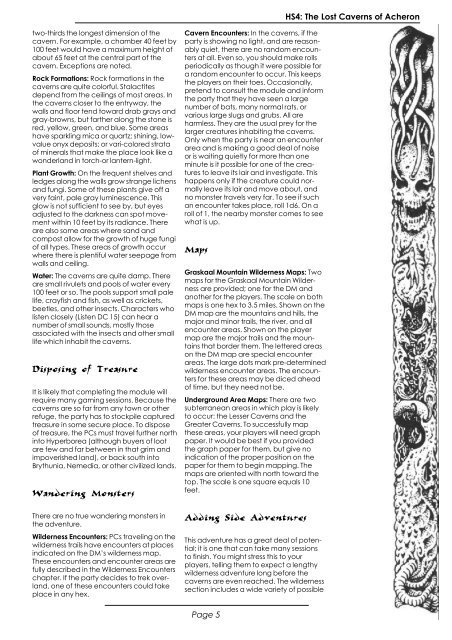HS4 The Lost Caverns of Acheron - Hyborian Age - Xoth
HS4 The Lost Caverns of Acheron - Hyborian Age - Xoth
HS4 The Lost Caverns of Acheron - Hyborian Age - Xoth
Create successful ePaper yourself
Turn your PDF publications into a flip-book with our unique Google optimized e-Paper software.
<strong>HS4</strong>: <strong>The</strong> <strong>Lost</strong> <strong>Caverns</strong> <strong>of</strong> <strong>Acheron</strong><br />
two-thirds the longest dimension <strong>of</strong> the<br />
cavern. For example, a chamber 40 feet by<br />
100 feet would have a maximum height <strong>of</strong><br />
about 65 feet at the central part <strong>of</strong> the<br />
cavern. Exceptions are noted.<br />
Rock Formations: Rock formations in the<br />
caverns are quite colorful. Stalactites<br />
depend from the ceilings <strong>of</strong> most areas. In<br />
the caverns closer to the entryway, the<br />
walls and floor tend toward drab grays and<br />
gray-browns, but farther along the stone is<br />
red, yellow, green, and blue. Some areas<br />
have sparkling mica or quartz; shining, lowvalue<br />
onyx deposits; or vari-colored strata<br />
<strong>of</strong> minerals that make the place look like a<br />
wonderland in torch-or lantern-light.<br />
Plant Growth: On the frequent shelves and<br />
ledges along the walls grow strange lichens<br />
and fungi. Some <strong>of</strong> these plants give <strong>of</strong>f a<br />
very faint, pale gray luminescence. This<br />
glow is not sufficient to see by, but eyes<br />
adjusted to the darkness can spot movement<br />
within 10 feet by its radiance. <strong>The</strong>re<br />
are also some areas where sand and<br />
compost allow for the growth <strong>of</strong> huge fungi<br />
<strong>of</strong> all types. <strong>The</strong>se areas <strong>of</strong> growth occur<br />
where there is plentiful water seepage from<br />
walls and ceiling.<br />
Water: <strong>The</strong> caverns are quite damp. <strong>The</strong>re<br />
are small rivulets and pools <strong>of</strong> water every<br />
100 feet or so. <strong>The</strong> pools support small pale<br />
life, crayfish and fish, as well as crickets,<br />
beetles, and other insects. Characters who<br />
listen closely (Listen DC 15) can hear a<br />
number <strong>of</strong> small sounds, mostly those<br />
associated with the insects and other small<br />
life which inhabit the caverns.<br />
Disposing <strong>of</strong> Treasure<br />
It is likely that completing the module will<br />
require many gaming sessions. Because the<br />
caverns are so far from any town or other<br />
refuge, the party has to stockpile captured<br />
treasure in some secure place. To dispose<br />
<strong>of</strong> treasure, the PCs must travel further north<br />
into Hyperborea (although buyers <strong>of</strong> loot<br />
are few and far between in that grim and<br />
impoverished land), or back south into<br />
Brythunia, Nemedia, or other civilized lands.<br />
Wandering Monsters<br />
<strong>The</strong>re are no true wandering monsters in<br />
the adventure.<br />
Wilderness Encounters: PCs traveling on the<br />
wilderness trails have encounters at places<br />
indicated on the DM’s wilderness map.<br />
<strong>The</strong>se encounters and encounter areas are<br />
fully described in the Wilderness Encounters<br />
chapter. If the party decides to trek overland,<br />
one <strong>of</strong> these encounters could take<br />
place in any hex.<br />
Cavern Encounters: In the caverns, if the<br />
party is showing no light, and are reasonably<br />
quiet, there are no random encounters<br />
at all. Even so, you should make rolls<br />
periodically as though it were possible for<br />
a random encounter to occur. This keeps<br />
the players on their toes. Occasionally,<br />
pretend to consult the module and inform<br />
the party that they have seen a large<br />
number <strong>of</strong> bats, many normal rats, or<br />
various large slugs and grubs. All are<br />
harmless. <strong>The</strong>y are the usual prey for the<br />
larger creatures inhabiting the caverns.<br />
Only when the party is near an encounter<br />
area and is making a good deal <strong>of</strong> noise<br />
or is waiting quietly for more than one<br />
minute is it possible for one <strong>of</strong> the creatures<br />
to leave its lair and investigate. This<br />
happens only if the creature could normally<br />
leave its lair and move about, and<br />
no monster travels very far. To see if such<br />
an encounter takes place, roll 1d6. On a<br />
roll <strong>of</strong> 1, the nearby monster comes to see<br />
what is up.<br />
Maps<br />
Graskaal Mountain Wilderness Maps: Two<br />
maps for the Graskaal Mountain Wilderness<br />
are provided; one for the DM and<br />
another for the players. <strong>The</strong> scale on both<br />
maps is one hex to 3.5 miles. Shown on the<br />
DM map are the mountains and hills, the<br />
major and minor trails, the river, and all<br />
encounter areas. Shown on the player<br />
map are the major trails and the mountains<br />
that border them. <strong>The</strong> lettered areas<br />
on the DM map are special encounter<br />
areas. <strong>The</strong> large dots mark pre-determined<br />
wilderness encounter areas. <strong>The</strong> encounters<br />
for these areas may be diced ahead<br />
<strong>of</strong> time, but they need not be.<br />
Underground Area Maps: <strong>The</strong>re are two<br />
subterranean areas in which play is likely<br />
to occur: the Lesser <strong>Caverns</strong> and the<br />
Greater <strong>Caverns</strong>. To successfully map<br />
these areas, your players will need graph<br />
paper. It would be best if you provided<br />
the graph paper for them, but give no<br />
indication <strong>of</strong> the proper position on the<br />
paper for them to begin mapping. <strong>The</strong><br />
maps are oriented with north toward the<br />
top. <strong>The</strong> scale is one square equals 10<br />
feet.<br />
Adding Side Adventures<br />
This adventure has a great deal <strong>of</strong> potential;<br />
it is one that can take many sessions<br />
to finish. You might stress this to your<br />
players, telling them to expect a lengthy<br />
wilderness adventure long before the<br />
caverns are even reached. <strong>The</strong> wilderness<br />
section includes a wide variety <strong>of</strong> possible<br />
Page 5



